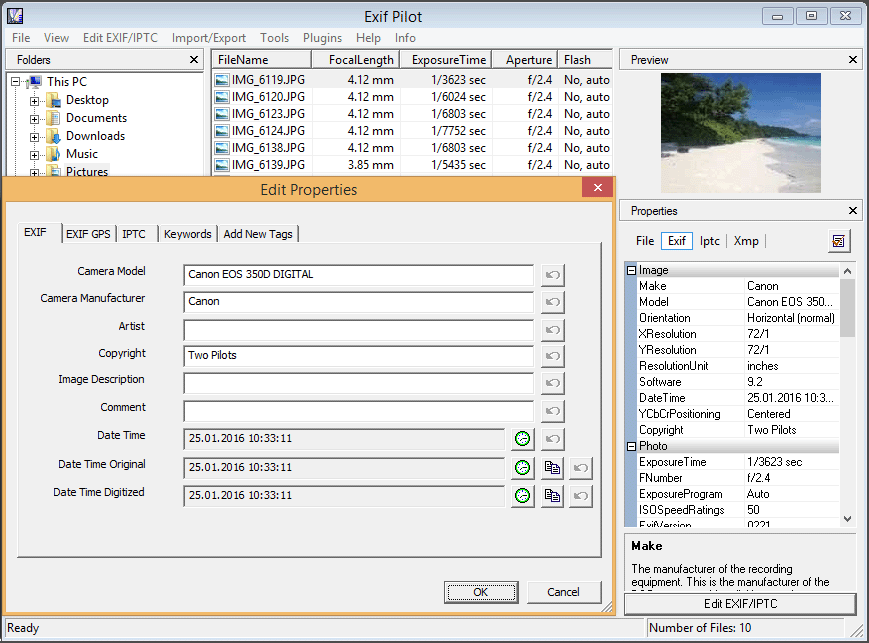
The Exif format has a number of drawbacks, mostly relating to its use of legacy file structures.
#Read exif data mac software
Software libraries, such as libexif for C and Adobe XMP Toolkit or Exiv2 for C++, Metadata Extractor for Java, PIL/Pillow for Python, LEADTOOLS or ExifTool for Perl, parse Exif data from files and read/write Exif tag values. Many image gallery programs also recognise Exif data and optionally display it alongside the images. While many recent image manipulation programs recognize and preserve Exif data when writing to a modified image, this is not the case for most older programs. Photo-sharing communities like Panoramio, locr or Flickr equally allow their users to upload geocoded pictures or to add geolocation information online.Įxif data are embedded within the image file itself. The process of adding geographic information to a photograph is known as geotagging. Some cameras can be paired with cellphones to provide the geolocation. Recorded GPS data can also be added to any digital photograph on a computer, either by correlating the time stamps of the photographs with a GPS record from a hand-held GPS receiver or manually by using a map or mapping software. Some other cameras have a separate GPS receiver that fits into the flash connector or hot shoe. As of 2014, many cameras and mobile phones have a built-in GPS receiver that stores the location information in the Exif header when a picture is taken. The Exif format has standard tags for location information. When these formats are used as Exif/DCF files together with the DCF specification (for better interoperability among devices of different types), their scope shall cover devices, recording media, and application software that handle them. In addition, Exif also defines a Global Positioning System sub-IFD using the TIFF Private Tag 0x8825, holding location information, and an "Interoperability IFD" specified within the Exif sub-IFD, using the Exif tag 0xA005.įormats specified in Exif standard are defined as folder structures that are based on Exif-JPEG and recording formats for memory. When Exif is employed in TIFF files (also when used as "an embedded TIFF file" mentioned earlier), the TIFF Private Tag 0x8769 defines a sub-Image File Directory (IFD) that holds the Exif specified TIFF Tags. When Exif is employed for JPEG files, the Exif data are stored in one of JPEG's defined utility Application Segments, the APP1 (segment marker 0xFFE1), which in effect holds an entire TIFF file within. The Metadata Working Group has guidelines on mapping tags between these standards. For descriptive metadata, there is an overlap between Exif, IPTC Information Interchange Model and XMP info, which also can be embedded in a JPEG file. On several image specific properties, there is a large overlap between the tags defined in the TIFF, Exif, TIFF/EP, and DCF standards. The Exif tag structure is borrowed from TIFF files. This section needs expansion with: changes. A thumbnail for previewing the picture on the camera's LCD screen, in file managers, or in photo manipulation software.

#Read exif data mac iso
This includes static information such as the camera model and make, and information that varies with each image such as orientation (rotation), aperture, shutter speed, focal length, metering mode, and ISO speed information. Digital cameras will record the current date and time and save this in the metadata.

The metadata tags defined in the Exif standard cover a broad spectrum: Exif is supported by almost all camera manufacturers. The latest version 2.3 was released on 26 April 2010, and revised to 2.31 in July 2013 and revised to 2.32 on, was jointly formulated by JEITA and CIPA. Version 2.21 (with Adobe RGB support) is dated 11 July 2003, but was released in September 2003 following the release of DCF 2.0. " Exif Print"), dated 20 February 2002 and released in April 2002. JEITA established Exif version 2.2 (a.k.a. Version 2.1 of the specification is dated 12 June 1998. The Japan Electronic Industries Development Association (JEIDA) produced the initial definition of Exif.


 0 kommentar(er)
0 kommentar(er)
